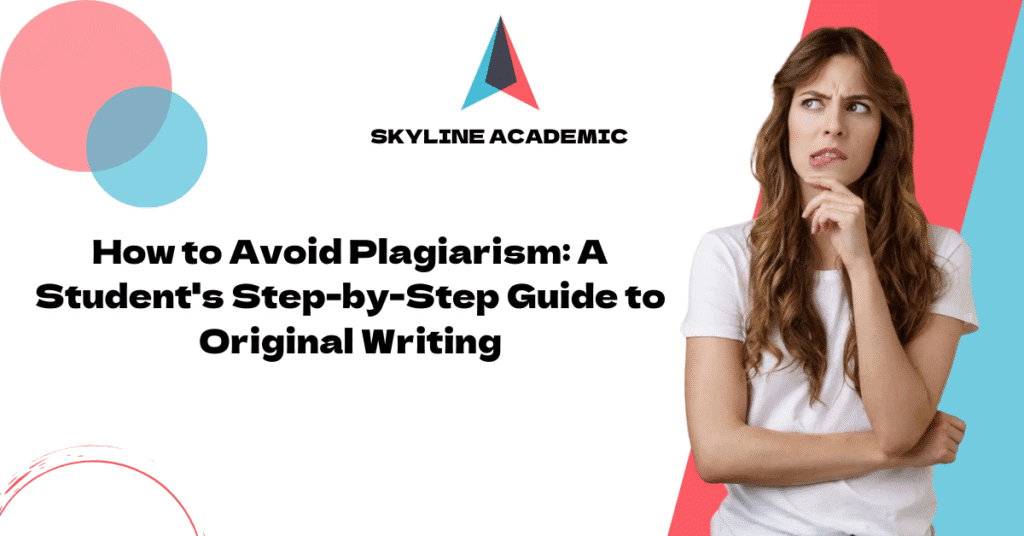How to Avoid Plagiarism: A Student’s Step-by-Step Guide to Original Writing
Plagiarism represents “academic theft” and stands as a serious violation of academic integrity that brings severe penalties . Students who use someone else’s work without credit don’t just break rules—they cheat themselves .
The unacknowledged and inappropriate use of another writer’s ideas or words defines plagiarism . Students need to understand what plagiarism means before they can avoid it. Several methods work to prevent plagiarism, and proper documentation tops the list. Source citation helps writers build credibility and learn information that matters to their studies . Strong anti-plagiarism strategies protect academic reputation and build vital research skills.
Unintentional plagiarism mistakes can happen , but students can learn proper prevention techniques. Documentation of sources remains the quickest way to avoid issues, even with data or ideas instead of direct quotes . Skyline Academic’s plagiarism checkers help spot potential problems before submission. These tools give students confidence about their work’s originality.
This detailed piece explores proven methods to avoid plagiarism, common mistakes to watch for, and tools that support academic integrity.
What Is Plagiarism and Why It Matters
The Oxford University defines plagiarism as “presenting work or ideas from another source as your own, with or without consent of the original author, by incorporating it into your work without full acknowledgement” [1]. This definition includes all published and unpublished material, AI-generated content, and your own work that you reuse without citation.
Understanding the definition of plagiarism
Plagiarism goes beyond simple text copying. Students should know about direct plagiarism (copying word-for-word without attribution), mosaic plagiarism (using phrases without quotation marks), self-plagiarism (reusing previous work), and accidental plagiarism (wrong citations) [2]. Students often find it hard to separate their ideas from source material, which leads to mistakes [3].
Why students must care about originality
Original work shows intellectual honesty and respect for academia. Oxford University states that plagiarism means students “have failed to complete the learning process” [1]. Universities want to help students “know and speak their own mind” rather than copy others’ views [1]. Original writing helps develop critical thinking and a unique voice. Your original work builds trust and credibility in academic circles [4].
Consequences of academic dishonesty
Plagiarism penalties vary based on how serious the offense is. Students might get zero marks, fail courses, or face academic probation [5]. Serious cases can lead to suspension or expulsion [6]. The impact goes beyond academics and can hurt career prospects. Companies might question degrees earned through dishonest means, which could put public safety at risk in fields like medicine, engineering, or law [7].
Most schools use plagiarism detection software like Turnitin to find uncited or wrongly cited work [8]. Students who understand these tools can avoid plagiarism better. Skyline Academic has complete resources to help students with proper citations and original writing techniques. These resources are a great way to get help maintaining academic integrity throughout their educational experience.
Common Types of Plagiarism Students Should Know

Image Source: The Visual Communication Guy
Students must know how everything in plagiarism works to develop effective strategies to avoid plagiarism in their academic work. This knowledge helps them protect their academic integrity and reputation.
Direct plagiarism
Writers commit direct plagiarism by copying someone else’s work word-for-word without attribution and quotation marks [9]. This violation ranks among the most serious breaches of academic honesty. Students who take exact text from a source and present it as their own face severe consequences [10]. These penalties often include expulsion and potential legal action for copyright violations [11].
Paraphrasing without citation
Students sometimes change the words from an original source but use the ideas without giving credit [12]. You need to credit the original source of the idea even if you use your own words [13]. Good paraphrasing means completely rewording the content while keeping the original meaning—and providing proper citation [14].
Self-plagiarism
Self-plagiarism happens when you reuse your previously published or submitted work without proper acknowledgment [15]. Many students think reusing their own work is fine, but submitting the same paper for different classes without permission breaks academic dishonesty rules [16]. Research shows duplicate publication rates in biomedical literature vary widely—from 1% in one journal to 28% in another [15].
Improper use of quotations
You commit plagiarism by not using quotation marks for exact words, even if you cite the source [17]. Use quotation marks whenever you borrow three or more consecutive words from another source [17]. Mosaic or patchwork plagiarism happens when you combine parts from different sources and change just a few words without proper attribution [9].
Misuse of AI-generated content
AI-generated content has become a major concern in academic settings. Students submitting AI-generated work as their own commit plagiarism [18]. Turnitin reviewed more than 200 million writing assignments and found that 10% showed AI use, with 3% being mostly AI-generated [19]. Skyline Academic’s plagiarism detection tools can spot AI-generated content, which helps students maintain their academic integrity in this changing digital world.
Step-by-Step Strategies for Avoiding Plagiarism

Image Source: LibGuides
Students can develop effective strategies for avoiding plagiarism by understanding proper research and writing techniques. Good habits protect academic integrity throughout a student’s career when these methods become second nature.
Take clear and hosted notes
Good note-taking forms the foundations of preventing accidental plagiarism. Students should label their notes with source information and distinguish between direct quotes, paraphrased content, and their own ideas [20]. The quickest way to do this involves marking your thoughts with “ME” in parentheses and others’ ideas with author information like “SMITH, 2020” [1]. This approach helps track information sources and makes proper citation easier when writing.
Paraphrase using your own understanding
You need to really understand the original text to paraphrase well. Read something carefully, put it aside and write it in your own words [3]. Your version should be compared with the original text for refinement. Good paraphrasing needs complete rewording while keeping the original meaning—and source citation remains essential [21]. Here are some techniques:
- Change words from one part of speech to another
- Use synonyms
- Alter sentence structures
- Change word order
Use quotation marks for exact words
Writers must use quotation marks with someone’s exact words. The writer’s responsibility lies in representing other people’s words accurately—inaccurate quotes may be plagiarism [22]. Brief quoted material works best. Quotes under 40 words should be incorporated into paragraphs with quotation marks. Longer passages need indented block formatting without quotation marks [23].
Cite all sources properly
Citations are the life-blood of academic integrity. A proper citation has author name, publication date, title, and source location [24]. Different disciplines need different citation styles (APA, MLA, Chicago), so ask your professor about specific requirements. Source tracking throughout research helps—you don’t want to find the perfect study only to lose its source information [25].
Check what counts as common knowledge
Common knowledge means information that’s accessible to more people and doesn’t need citation. This covers prominent facts and dates found without documentation in at least five credible sources [26]. Statistics, interpretations, and arguments always need citation [27]. Your audience matters when deciding what’s common knowledge—obvious information in one field might be specialized in another.
Ask when in doubt
The best approach is to ask for guidance whenever you’re unsure about plagiarism. Harvard’s writing center says, “It’s always better to ask questions than it is to wait for an instructor to respond to work that you have turned in for a grade” [28]. Skyline’s academic resources are a great way to get detailed guidance on avoiding plagiarism and maintaining academic integrity. Writing centers, tutors, and professors help students navigate citation challenges effectively.
Tools and Habits to Stay Original
Academic integrity needs both knowledge and practical tools that help students write original content. Students now have access to great resources that make it easier to avoid plagiarism.
Use plagiarism checkers wisely
Turnitin and similar plagiarism detection software compare your work against huge databases of academic papers, websites, and publications [29]. These tools create similarity reports that point out potential problems, but they don’t decide if something is plagiarism—they just highlight areas you should review [6]. You should use multiple checkers to get a full picture, since one checker might miss some copied text [30].
Keep track of your sources
Good source management helps prevent accidental plagiarism. A research log lets you save bibliographic information and stable links as you discover sources [31]. Each source entry should include citation details, useful quotes, and your thoughts about the material. Make sure you clearly mark which ideas are yours and which belong to others [32].
Use citation tools like Zotero
Zotero is a free citation management tool that helps you collect, organize, and cite research [33]. Skyline’s academic resources are a great way to get help with original work. Our website offers plagiarism checkers, citation guides, and writing assistance. Zotero lets you grab citations straight from browsers, create bibliographies in thousands of styles, and merge with word processors to add citations [34].
Visit your writing center for help
Writing centers are a great way to get support with citation questions and proper paraphrasing techniques. Students who ask for help with drafts show they take academic work seriously [32]. A writing coach can spot passages that need better citation [32].
Conclusion
Academic success depends on your ability to avoid plagiarism. The strategies we discussed will guide you to write original content and maintain scholarly integrity. Your authentic academic work needs proper note-taking, good paraphrasing skills, and regular citation practices. These skills will protect you from negative consequences and help improve your critical thinking and writing abilities.
Skyline Academic’s plagiarism detection tools compare your work against big databases of academic papers, websites, and publications. Students who learn proper citation early face fewer problems with similarity reports. Running your work through Skyline Academic’s plagiarism checkers adds an extra safety check before submission. This helps you spot and fix potential problems right away.
Plagiarism’s impact goes well beyond academic penalties. Your future career path, professional image, and personal development rely on skills you gain through honest academic work. Tools like Zotero and Skyline Academic’s resources give busy students a quick way to manage citations.
Academic integrity shows your steadfast dedication to real learning. Every cited source, well-paraphrased paragraph, and properly quoted text shows respect for academia while developing your unique voice. Don’t call it an obstacle – plagiarism prevention is vital to your educational growth. Skyline Academic stands ready as your trusted partner to help you maintain originality and reach your full academic potential.
FAQs
Q1. What are the most effective strategies to avoid plagiarism?
The most effective strategies include proper citation of sources, using quotation marks for exact words, paraphrasing in your own words while still citing the original source, keeping organized notes, and using plagiarism detection tools before submission.
Q2. How can I properly paraphrase without plagiarizing?
To paraphrase effectively, thoroughly understand the original text, set it aside, and then rewrite the idea in your own words. Compare your version with the original, refine as needed, and always cite the source. Use techniques like changing word order, altering sentence structures, and using synonyms.
Q3. Is it plagiarism if I reuse my own work?
Yes, reusing your own previously submitted work without proper acknowledgment is considered self-plagiarism. Even if it’s your own work, submitting the same paper for different classes without permission constitutes academic dishonesty.
Q4. How do I know if something is common knowledge and doesn’t need citation?
Common knowledge generally refers to widely known facts found undocumented in at least five credible sources. However, statistics, interpretations, and arguments always require citation. Consider your audience when determining what might be common knowledge in your field.
Q5. Can using AI-generated content be considered plagiarism?
Yes, submitting AI-generated work as your own is considered plagiarism. It’s important to properly attribute any AI-generated content you use and to understand your institution’s policies regarding the use of AI tools in academic work.
References
[1] – https://guides.library.ucla.edu/citing/plagiarism/avoid
[2] – https://www.samwell.ai/blog/types-of-academic-dishonesty
[3] – https://www.niu.edu/academic-integrity/students/plagiarism/tips-on-avoiding.shtml
[4] – https://www.smithfieldtimes.com/2024/05/28/the-importance-of-originality-in-academic-writing-and-how-to-achieve-it/
[5] – https://bestcolleges.com/ask-an-advisor/consequences-academic-dishonesty/
[6] – https://cte.ku.edu/careful-use-plagiarism-checkers
[7] – https://www.niu.edu/academic-integrity/students/consequences/index.shtml
[8] – https://www.usnews.com/education/best-colleges/articles/how-cheating-in-college-hurts-students
[9] – https://www.bowdoin.edu/dean-of-students/conduct-review-board/academic-honesty-and-plagiarism/common-types-of-plagiarism.html
[10] – https://brandwell.ai/blog/direct-plagiarism/
[11] – https://guides.library.unt.edu/plagiarism/direct
[12] – https://www.niu.edu/academic-integrity/faculty/committing/examples/paraphrasing-without-citation.shtml
[13] – https://law-richmond.libguides.com/c.php?g=998384&p=7227189
[14] – https://guides.library.upenn.edu/citationpractices/paraphrase
[15] – https://ori.hhs.gov/self-plagiarism
[16] – https://oai.missouri.edu/students/self-plagiarism/
[17] – https://honor.virginia.edu/understanding-fraud
[18] – https://inspera.com/ai/examples-of-ai-misuse-in-education/
[19] – https://www.edweek.org/technology/new-data-reveal-how-many-students-are-using-ai-to-cheat/2024/04
[20] – https://undergraduateswrite.com/2019/05/31/avoid-plagiarism-take-good-notes/
[21] – https://www.lib.sfu.ca/about/branches-depts/slc/writing/sources/techniques-paraphrasing
[22] – https://owl.purdue.edu/owl/general_writing/punctuation/quotation_marks/extended_rules_for_quotation_marks.html
[23] – https://uq.pressbooks.pub/academicwritingskills/chapter/paraphrasing-skills/
[24] – https://pitt.libguides.com/citationhelp
[25] – https://www.snhu.edu/about-us/newsroom/education/how-to-cite-a-research-paper
[26] – https://owl.purdue.edu/owl/avoiding_plagiarism/common-knowledge_attribution.html
[27] – https://www.scribbr.com/plagiarism/common-knowledge/
[28] – https://usingsources.fas.harvard.edu/how-avoid-plagiarism-0
[29] – https://www.turnitin.com/solutions/academic-integrity
[30] – https://www.yomu.ai/blog/plagiarism-checker-academic-paper-user-guide
[31] – https://libguides.umflint.edu/research/citing
[32] – https://writingcenter.unc.edu/tips-and-tools/plagiarism/
[33] – https://library.caltech.edu/introacademicwriting/zotero
[34] – https://guides.libraries.psu.edu/zotero/citations


![Is Cyber Security Hard Expert Guidance Makes It Easy [2025]](https://skylineacademic.com/wp-content/uploads/2025/10/is-cyber-security-hard-expert-guidance-makes-it-easy.png)
